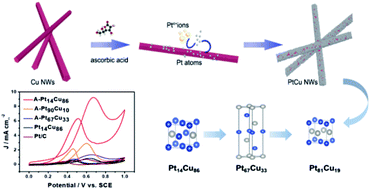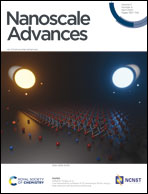Bimetallic and postsynthetically alloyed PtCu nanostructures with tunable reactivity for the methanol oxidation reaction†
Abstract
Designing effective catalysts by controlling morphology and structure is key to improving the energy efficiency of fuel cells. A good understanding of the effects of specific structures on electrocatalytic activity, selectivity, and stability is needed. Here, we propose a facile method to synthesize PtCu bimetallic nanostructures with controllable compositions by using Cu nanowires as a template and ascorbic acid as a reductant. A further annealing process provided the alloy PtCu with tunable crystal structures. The combination of distinct structures with tunable compositions in the form of PtCu nanowires provides plenty of information for better understanding the reaction mechanism during catalysis. HClO4 cyclic voltammetry (CV) tests confirmed that various phase transformations occurred in bimetallic and alloy samples, affecting morphology and unit cell structures. Under a bifunctional synergistic effect and the influence of the insertion of a second metal, the two series of structures show superior performance toward methanol electrooxidation. Typically, the post-product alloy A-Pt14Cu86 with a cubic structure (a = 3.702 Å) has better methanol oxidation reaction (MOR) catalysis performance. Density functional theory (DFT) calculations were performed to determine an optimal pathway using the Gibbs free energy and to verify the dependence of the electrocatalytic performance on the lattice structure via overpotential changes. Bimetallic PtCu has high CO tolerance, maintaining high stability. This work provides an approach for the systematic design of novel catalysts and the exploration of electrocatalytic mechanisms for fuel cells and other related applications.



 Please wait while we load your content...
Please wait while we load your content...